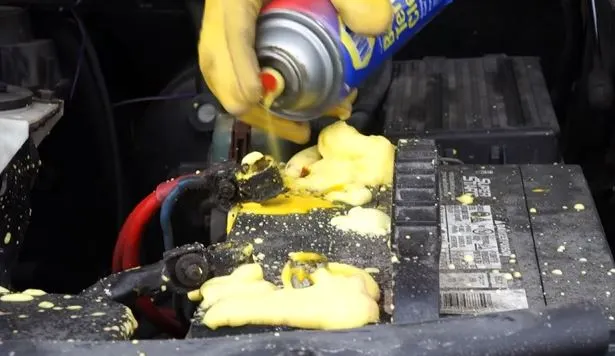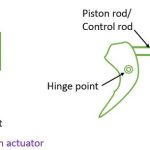Batteries play a crucial role in powering various systems on an aircraft. However, over time, batteries can corrode, leading to potentially serious consequences. In this article, we’ll take a closer look at battery corrosion and its effects on aircraft.
What is Battery Corrosion?

Battery corrosion is the process by which a battery’s metal components deteriorate over time. This process is typically caused by the battery’s acidic electrolyte, which can leak out of the battery and corrode any metal components it comes into contact with. The corrosion can build up over time and cause damage to the battery and other nearby components.
What type of battery corrode most?
The type of battery that corrodes the most is the lead-acid battery. Lead-acid batteries are commonly used in vehicles, including aircraft, as they are relatively inexpensive and provide high power output. However, these batteries can also be prone to corrosion due to the acid electrolyte used in them.
The acid electrolyte can leak out of the battery and corrode any metal components it comes into contact with, causing damage and potentially reducing the lifespan of the battery. Therefore, it is essential to regularly inspect and maintain lead-acid batteries in order to prevent corrosion and ensure safe and efficient operation of aircraft systems.
Why do lead acid batteries corrode more than other types of batteries?

Lead-acid batteries tend to corrode more than other types of batteries because of their construction and the type of electrolyte used in them. Lead-acid batteries contain lead plates that are immersed in a sulfuric acid electrolyte.
During the discharge and recharge cycles, the acid electrolyte can break down the lead plates and produce lead sulfate deposits, which can build up on the plates and reduce the battery’s capacity and lifespan.
Additionally, the acid electrolyte can leak out of the battery and corrode any metal components it comes into contact with, leading to further damage and potentially compromising the safety and efficiency of the battery and associated aircraft systems. To minimize the risk of corrosion and ensure the longevity and efficiency of lead-acid batteries, regular inspection, cleaning, and maintenance are necessary.
Other types of batteries, such as lithium-ion batteries, use different materials and electrolytes that are less prone to corrosion, but they also require proper maintenance and handling to ensure safe and efficient operation.
Affected areas of battery corrosion

Battery corrosion can affect a variety of areas, including:
- Battery terminals: Corrosion can accumulate on the battery terminals, which are the metal posts on the top of the battery that connects to the cables.
- Cable ends: Battery corrosion can also affect the cable ends, which are the metal parts that connect to the battery terminals.
- Battery tray: Corrosion can also occur on the battery tray, which is the metal or plastic plate that holds the battery in place.
- Battery case: Battery corrosion can affect the battery case, which is the outer covering of the battery.
- Engine bay: Corrosion from the battery can spread to other metal parts in the engine bay, such as bolts and brackets.
- Electrical system: Corrosion on the battery or cables can cause electrical problems in the vehicle, such as poor connections, a weak or dead battery, or difficulty starting the engine.
It is important to regularly check for and clean up any signs of battery corrosion to prevent these issues from occurring.
How to clean battery corrosion?

To clean battery corrosion, you will need the following items:
- Baking soda
- Water
- Disposable gloves
- Safety glasses or goggles
- A toothbrush or wire brush
- Cloth or paper towel
- Rust inhibitor spray (optional)
Here are the steps to clean battery corrosion:
- Put on disposable gloves and safety glasses or goggles to protect yourself from battery acid and corrosion.
- Mix a tablespoon of baking soda with a cup of water until it forms a paste.
- Disconnect the negative cable first, then the positive cable from the battery terminals. Use a wrench or pliers if necessary.
- Use the toothbrush or wire brush to apply the baking soda paste to the battery terminals, cable ends, and any other areas with visible corrosion. Scrub gently but thoroughly to remove the corrosion.
- Use a cloth or paper towel to wipe away any remaining paste and corrosion residue.
- If desired, spray a rust inhibitor on the battery terminals and cable ends to prevent future corrosion.
- Reconnect the positive cable first, then the negative cable to the battery terminals. Tighten the connections securely with a wrench or pliers.
Note: If you see any signs of cracks or damage on the battery, it is recommended to replace it instead of attempting to clean it. Additionally, make sure the area is well-ventilated and avoid touching your face or eyes while cleaning the battery corrosion.
is there any solution or battery corrosion cleaner?
Yes, there are several commercial solutions and battery corrosion cleaners available that can help remove battery corrosion. Some examples include:
- Battery terminal cleaner: This is a spray or foam cleaner specifically designed to clean battery terminals and cable ends. It usually contains acid-neutralizing compounds to dissolve corrosion and prevent future buildup.
- Baking soda and water mixture: As mentioned earlier, you can make a cleaning paste with baking soda and water to remove battery corrosion.
- Coca-Cola: Some people use Coca-Cola to clean battery corrosion, as the carbonic acid in the soda can dissolve the corrosion. However, this is not a recommended method as it can be messy and potentially damaging to the battery.
- Commercial rust removers: There are also rust removers available that can dissolve battery corrosion. However, these can be harsh chemicals, so it’s important to follow the instructions carefully and wear protective gloves and goggles.
When using any commercial solution or battery corrosion cleaner, make sure to read the instructions carefully and follow all safety precautions. Always wear gloves and eye protection and work in a well-ventilated area.
Effects of Battery Corrosion on Aircraft
Battery corrosion can have a significant impact on an aircraft’s systems and overall safety. Here are some of the potential effects of battery corrosion:
- Reduced Battery Life: Battery corrosion can cause a reduction in the overall lifespan of an aircraft’s battery. This can lead to more frequent battery replacements, which can be costly and time-consuming.
- Electrical System Malfunctions: Corrosion can also lead to electrical system malfunctions, as the corroded metal components can disrupt the flow of electricity. This can cause issues with various aircraft systems, such as communication, navigation, and lighting.
- Fire Hazard: Corrosion can create a fire hazard by compromising the integrity of the battery’s casing. This can lead to leaks, short circuits, and potentially, a battery fire.
- Safety Risks: Any malfunction or failure of an aircraft’s systems can pose safety risks to passengers and crew. Battery corrosion can compromise the aircraft’s ability to function properly and increase the risk of accidents.
Preventing Battery Corrosion
Preventing battery corrosion is essential to ensure the safety and efficiency of an aircraft. Remember the following tips to prevent battery corrosion:
- Regular Maintenance: Regular maintenance of the aircraft’s battery and other components can help identify and address any corrosion early on.
- Proper Storage: Proper storage of the battery can also help prevent corrosion. Batteries should be stored in a dry, cool place away from any moisture or heat sources.
- Cleaning: Regular cleaning of the battery and other components can help remove any buildup of dirt, grime, or other contaminants that can lead to corrosion.
Conclusion
Battery corrosion can have serious consequences for an aircraft’s systems and overall safety. Regular maintenance, proper storage, and cleaning are essential to prevent battery corrosion and ensure the longevity and efficiency of an aircraft’s battery and systems. By understanding the causes and effects of battery corrosion, aircraft operators and maintenance crews can take proactive measures to keep their aircraft safe and in good working order.


